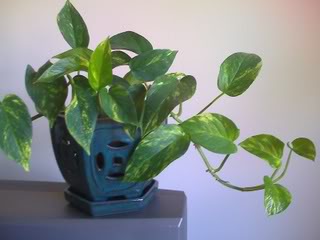Raising plants indoors is a home-healthy move because of their ability to clean the air of carbon dioxide, but their benefits don't stop there. It turns out that the average houseplant can remove formaldehyde, benzene, and a host of other toxins that plague typical indoor air.  It may come as a surprise, but indoor air is often much more polluted than the air outside. Off-gassing from paints, adhesives, and even unsuspected items, such as clothing and tap water, infuse the air we breathe will a host of chemicals, many of which are proven carcinogens. Newer, tighter homes are especially problematic, since they limit the amount of fresh air that can make its way into the interior. Compound this with the average time that citizens of developed nations spend indoors -- approximately 90% -- and the need for remediation becomes clear. Answering this need can be as simple as the addition of green, leafy plants to the living space.
It may come as a surprise, but indoor air is often much more polluted than the air outside. Off-gassing from paints, adhesives, and even unsuspected items, such as clothing and tap water, infuse the air we breathe will a host of chemicals, many of which are proven carcinogens. Newer, tighter homes are especially problematic, since they limit the amount of fresh air that can make its way into the interior. Compound this with the average time that citizens of developed nations spend indoors -- approximately 90% -- and the need for remediation becomes clear. Answering this need can be as simple as the addition of green, leafy plants to the living space.
Interesting Facts
- Harmful indoor pollutants are responsible for more than 1.6 million deaths each year, according to a 2002 World Health Organization report.
- Removal of environmental airborne toxins with the aid of plants is called phytoremediation.
- In addition to the removal of these pollutants, plants can reduce stress, increase work performance, and reduce symptoms of ill health.
Study Performed by NASA
While researching the ability of plants to cleanse air in space stations, NASA made some fascinating and important discoveries concerning the role that houseplants play here on Earth. They tested the ability of a variety of plants to remove common volatile organic compounds (VOCs) from the air. The toxins tested include:
- benzene:
- found in petroleum-based indoor coatings, gasoline, inks, oils, paints, plastics, rubber, cleaning solutions, plastics, and exterior exhaust fumes emanating into buildings;
- an irritant and probable carcinogen. Inhalation of benzene has been reported to cause dizziness, weakness, euphoria, headache, nausea, blurred vision, respiratory diseases, tremors, irregular heartbeat, liver and kidney damage, paralysis and unconsciousness.
- trichloroethylene (TCE):
- found in a wide variety of products, such as inks, paints, lacquers, varnishes and adhesives;
- is a potent liver carcinogen.
- formaldehyde:
- found in virtually all indoor environments due to its widespread use in many kinds of products. Specifically, it may be found in:
- urea-formaldehyde foam insulation (UFFI), particleboard and pressed-wood products;
- paper products, such as grocery bags, waxed papers, facial tissues and paper towels;
- common household cleaning agents;
- stiffeners, wrinkle-resisters, water-repellents, fire-retardants and adhesive binders in floor coverings, carpet backings and permanent-press clothes; and
- heating and cooking fuels, such as natural gas and kerosene, and cigarette smoke.
- Formaldeyde causes watery eyes, nausea and wheezing. More seriously, the chemical is classified as carcinogenic to humans by the International Agency for Research on Cancer.
- found in virtually all indoor environments due to its widespread use in many kinds of products. Specifically, it may be found in:
- toluene:
- found in adhesives, disinfectants, rubber, printing ink, lacquers, and leather tanners;
- Symptoms in low doses include sleepiness, confusion, weakness, memory loss, nausea, loss of appetite, and hearing and color-vision loss. High levels of toluene may cause light-headedness, unconsciousness, and death.
In the NASA testing, flowering plants, such as chrysanthemums and gerbera daisies, effectively removed benzene from the chamber's atmosphere. Golden pothos, spider plants and philodendron were the most effective in removing formaldehyde molecules. Other top performers were red-edged dracaena and the Peace Lilly. The rest of the plants tested, with the exception of Chinese evergreen (Aglaonema modestum), were effective at removing at least one of the chemicals from the air. NASA researchers found that plants absorb airborne substances through tiny openings in their leaves, but roots and soil bacteria are also part of the purification process.
The study concluded that in an 1,800-square-foot house, occupants should incorporate 15 to 18 houseplants in 6- to 8-inch diameter containers to improve air quality. The larger and more vigorously they grow, the better.
India Study
The government of India published the results of a groundbreaking study in September of 2008 that analyzed the effects of certain  species of plants on indoor air quality. Three plant species -- areca palm, pothos (known as Mother-in-Law's Tongue), and the Money Plant -- were tested for 15 years at the Paharpur Business Centre and Software Technology Incubator Park in New Delhi. The building was 20 years old and 50,000 square feet, and it housed more than 1,200 plants for 300 workers. The study found that the building had the healthiest indoor air in the city. Specifically, compared to other buildings in New Delhi, the building showed reductions of:
species of plants on indoor air quality. Three plant species -- areca palm, pothos (known as Mother-in-Law's Tongue), and the Money Plant -- were tested for 15 years at the Paharpur Business Centre and Software Technology Incubator Park in New Delhi. The building was 20 years old and 50,000 square feet, and it housed more than 1,200 plants for 300 workers. The study found that the building had the healthiest indoor air in the city. Specifically, compared to other buildings in New Delhi, the building showed reductions of:
- eye irritation by 52%;
- respiratory conditions by 34%;
- headaches by 24%;
- lung impairment by 12%; and
- asthma by 9%.
In addition, energy costs were reduced by 15% because less outside air infiltration was required. Worker productivity showed an increase of 20%, perhaps as a result of fewer sick days and increased blood-oxygen levels.
In summary, plants can be used to enhance the air quality inside buildings.
http://www.homeinspectorusa.biz


Comments(5)